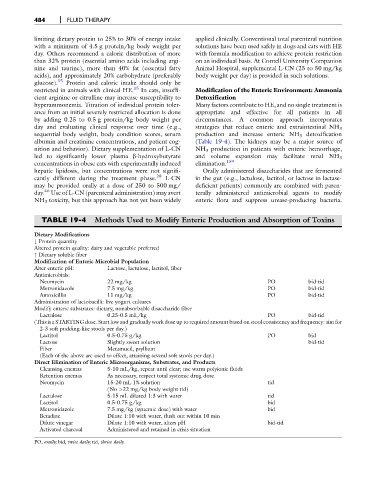Page 496 - Fluid, Electrolyte, and Acid-Base Disorders in Small Animal Practice
P. 496
484 FLUID THERAPY
limiting dietary protein to 25% to 30% of energy intake applied clinically. Conventional total parenteral nutrition
with a minimum of 4.5 g protein/kg body weight per solutions have been used safely in dogs and cats with HE
day. Others recommend a caloric distribution of more with formula modification to achieve protein restriction
than 32% protein (essential amino acids including argi- on an individual basis. At Cornell University Companion
nine and taurine), more than 40% fat (essential fatty Animal Hospital, supplemental L-CN (25 to 50 mg/kg
acids), and approximately 20% carbohydrate (preferably body weight per day) is provided in such solutions.
glucose). 15 Protein and caloric intake should only be
restricted in animals with clinical HE. 15 In cats, insuffi- Modification of the Enteric Environment: Ammonia
cient arginine or citrulline may increase susceptibility to Detoxification
hyperammonemia. Titration of individual protein toler- Many factors contribute to HE, and no single treatment is
ance from an initial severely restricted allocation is done appropriate and effective for all patients in all
by adding 0.25 to 0.5 g protein/kg body weight per circumstances. A common approach incorporates
day and evaluating clinical response over time (e.g., strategies that reduce enteric and extraintestinal NH 3
sequential body weight, body condition scores, serum production and increase enteric NH 3 detoxification
albumin and creatinine concentrations, and patient cog- (Table 19-4). The kidneys may be a major source of
nition and behavior). Dietary supplementation of L-CN NH 3 production in patients with enteric hemorrhage,
led to significantly lower plasma b-hydroxybutyrate and volume expansion may facilitate renal NH 3
concentrations in obese cats with experimentally induced elimination. 159
hepatic lipidosis, but concentrations were not signifi- Orally administered disaccharides that are fermented
cantly different during the treatment phase. 28 L-CN in the gut (e.g., lactulose, lactitol, or lactose in lactase-
may be provided orally at a dose of 250 to 500 mg/ deficient patients) commonly are combined with paren-
day. 46 Use of L-CN (parenteral administration) may avert terally administered antimicrobial agents to modify
NH 3 toxicity, but this approach has not yet been widely enteric flora and suppress urease-producing bacteria.
TABLE 19-4 Methods Used to Modify Enteric Production and Absorption of Toxins
Dietary Modifications
# Protein quantity
Altered protein quality: dairy and vegetable preferred
" Dietary soluble fiber
Modification of Enteric Microbial Population
Alter enteric pH: Lactose, lactulose, lactitol, fiber
Antimicrobials:
Neomycin 22 mg/kg PO bid-tid
Metronidazole 7.5 mg/kg PO bid-tid
Amoxicillin 11 mg/kg PO bid-tid
Administration of lactobacilli: live yogurt cultures
Modify enteric substrates: dietary, nonabsorbable disaccharide fiber
Lactulose 0.25-0.5 mL/kg PO bid-tid
(This is a STARTING dose. Start low and gradually work dose up to required amount based on stool consistency and frequency: aim for
2-3 soft pudding-like stools per day.)
Lactitol 0.5-0.75 g/kg PO bid
Lactose Slightly sweet solution bid-tid
Fiber Metamucil, psyllium
(Each of the above are used to effect, attaining several soft stools per day.)
Direct Elimination of Enteric Microorganisms, Substrates, and Products
Cleansing enemas 5-10 mL/kg, repeat until clear; use warm polyionic fluids
Retention enemas As necessary, respect total systemic drug dose
Neomycin 15-20 mL 1% solution tid
(No >22 mg/kg body weight tid)
Lactulose 5-15 mL diluted 1:3 with water tid
Lactitol 0.5-0.75 g/kg bid
Metronidazole 7.5 mg/kg (systemic dose) with water bid
Betadine Dilute 1:10 with water, flush out within 10 min
Dilute vinegar Dilute 1:10 with water, alters pH bid-tid
Activated charcoal Administered and retained in crisis situation
PO, orally; bid, twice daily; tid, thrice daily.

